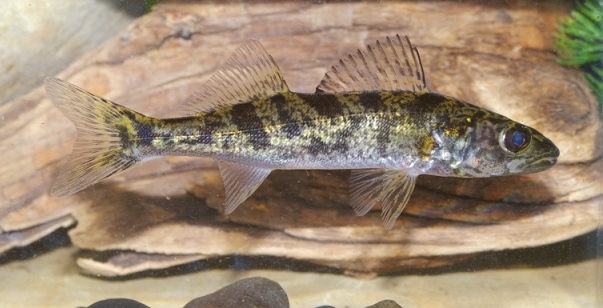Walleye
(Sander vitreus)

The walleye is the largest of nearly 250 species in the family Percidae found in North America.
Description
Walleye are a large predatory fish that have many sharp teeth in their mouth. The first dorsal fin has no spots and the membrane between the spines is opaque not clear like a sauger. Also, there is a large dark blotch at the rear base of the first dorsal fin. The body color of a walleye is typically olive, gray or silver color compared to the definite bronze or brown of a sauger. Walleye have a series of dark saddles over their back which can be seen on the upper part of their sides as thin vertical bars. Walleye also have large bright white areas at the edge of the lower part of their tail and anal fins.
Habitat and Habits
Walleye prefer clear to slightly turbid waters of large lakes and rivers. They usually occur in greatest abundance over reefs, shoals of gravel, bedrock, and other firm bottoms. Historically walleye were abundant in Lake Erie, the Ohio River and many of their larger tributaries. They are still abundant in Lake Erie an can be found upstream to the first dam in several of the larger tributaries to the lake. They are also still found in the Ohio River but are far out numbered by the sauger. The further up-stream toward Pittsburgh Pennsylvania you go the more common of a catch walleye become. Walleye are also stocked in several of Ohio's reservoirs
Reproduction and Care of the Young
Walleye spawn throughout the month of April when water temperatures are between 40 and 55° F. Walleye deposit their eggs in the riffle areas of tributary streams or over gravel to boulder-sized rocks in reef areas of Lake Erie. The eggs hatch in about 10 days. Females can lay as many as 400,000 eggs. Young walleye feed on zooplankton and insect larvae for several months before shifting over to a diet of small fish. No parental care is given by the adults.